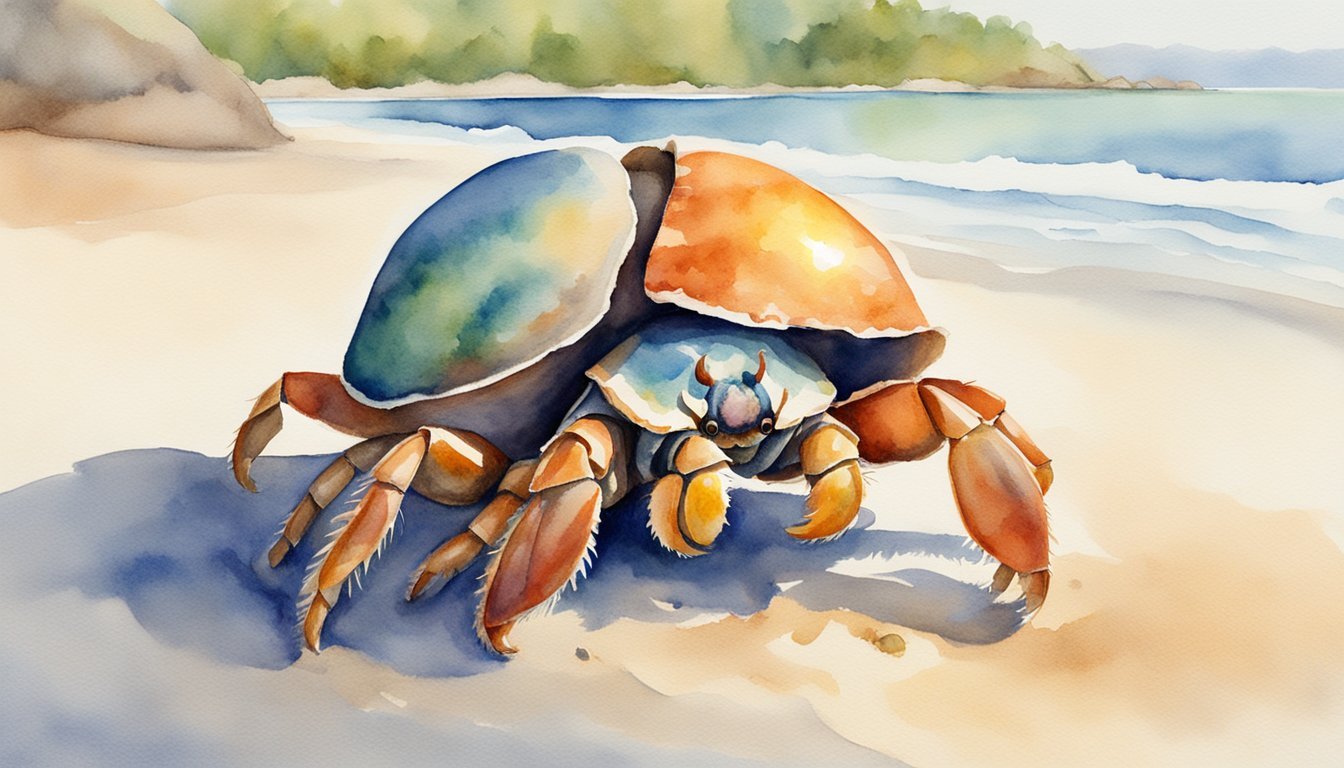Understanding Hermit Crabs
Hermit crabs are fascinating crustaceans with unique adaptations that allow them to inhabit scavenged mollusk shells for protection. This section explores their physical characteristics, diverse species and habitats, as well as their varied diet and feeding habits.
Physical Characteristics
Hermit crabs, members of the superfamily Paguroidea, are distinguished by their soft, asymmetrical abdomens which they protect by occupying empty shells. They possess a hard exoskeleton elsewhere, which provides support and protection for the rest of their bodies. These invertebrates are further equipped with gills for breathing, antennae for sensing their environment, and multiple legs that aid in movement and shell handling.
Species and Habitat
There are over 800 species of hermit crabs, split into two main categories: terrestrial and marine. Terrestrial hermit crabs are typically found in tropical regions, frequenting shorelines where they can access both land and sea. Meanwhile, their marine counterparts reside in saltwater environments, ranging from coral reefs to the deep sea. Each species is adapted to its specific habitat, but all share the common need for a shell to protect their vulnerable abdomen.
Diet and Feeding Habits
Hermit crabs are omnivores, feeding on a range of organic materials. Terrestrial species may consume fruits, vegetables, carrion, and more, while marine species often eat algae, seaweed, and detritus. They are opportunistic feeders, which means they will consume almost any food they can find, using their claws to grasp and manipulate their meals. Feeding habits can vary widely among different hermit crab species, reflecting the diversity present within the group.
Hermit Crab Care and Lifecycle

Hermit crabs are intriguing decapod crustaceans that require specific care to thrive, encompassing appropriate habitat conditions and understanding their unique molting and reproductive cycles. This section will explore the essentials of hermit crab care, their growth stages, and the environment best suited to maintain their health.
Shelter and Molting
Hermit crabs seek shelter in abandoned seashells to protect their soft abdomen, constantly searching for larger shells as they grow. This process, known as molting, involves a hermit crab shedding its exoskeleton to form a new one. During this vulnerable period, which can last several weeks, they retreat into their chosen shells for protection and when they emerge, their carapace is softer and requires time to harden.
Reproduction and Growth
Reproduction in hermit crabs begins with a male and female partially exiting their shells to mate. The female hermit crab can carry thousands of eggs, which she will carry for up to a month before releasing the larvae into the sea. The early life stages of hermit crabs are aquatic, where tiny zoea larvae develop into megalopae before eventually finding their first snail shell to inhabit and begin their terrestrial life.
Health and Environment
A healthy hermit crab environment mimics their natural habitat, with access to both land and water. Tanks should maintain a humidity of 75% or higher and a temperature between 75 and 85 degrees Fahrenheit. Substrate choices like coconut fiber provide ideal burrowing opportunities. Both freshwater and saltwater pools are essential for hydration and shell regulation. Proper diet, clean conditions, and the avoidance of tap water and plastic pollution contribute to their wellbeing, preventing stress and diseases which may require a veterinarian’s attention.
Research on the hermit crab’s habitat has shown that they often use coconut shells, coral fragments, and empty seashells as homes, showcasing their adaptability. To learn about how hermit crabs interact in their environment, including with anemones and sponges, and their peculiar shelter-seeking behavior, a resource detailing the Hermit Crab Life Cycle offers in-depth insights.
For those interested in creating a suitable habitat for pet hermit crabs, a comprehensive guide on how to care for Hermit Crabs can help establish a thriving terrarium. It details essential care requirements such as temperature control and the use of an under-tank heater, the importance of various hiding places, maintaining fresh water quality, and elements like substrate and humidity which can be measured with a hygrometer.
Providing proper nutrition for hermit crabs is also critical, and sources such as Hermit Crab Care Guide offer insight on an optimal diet. Besides commercial pellet food, hermit crabs benefit from the inclusion of vegetables and fruit in their feeding regimen.
For additional information and support for those with queries about hermit crab care, the Hermit Crab Association provides a platform with caresheets, guidelines, and an active community ready to help.

